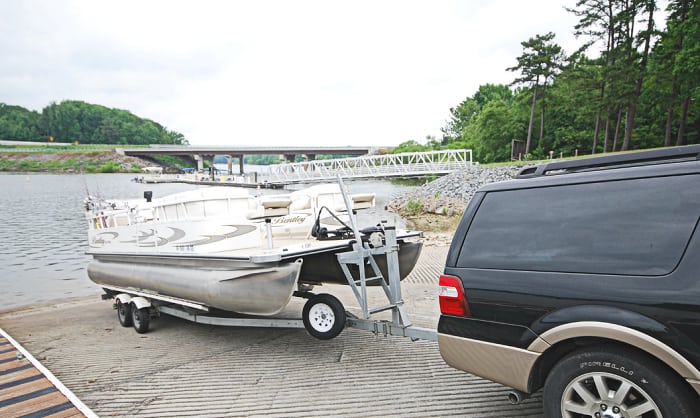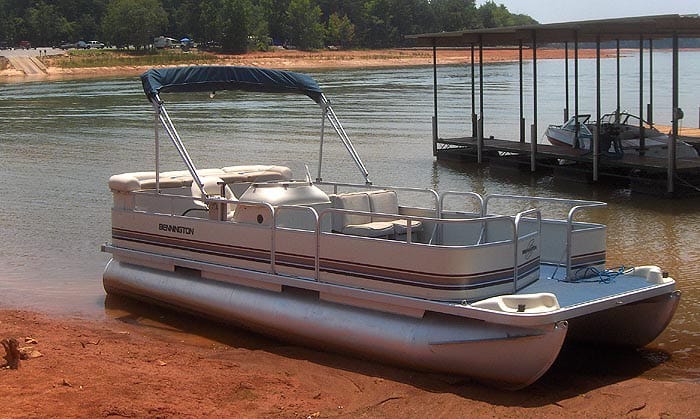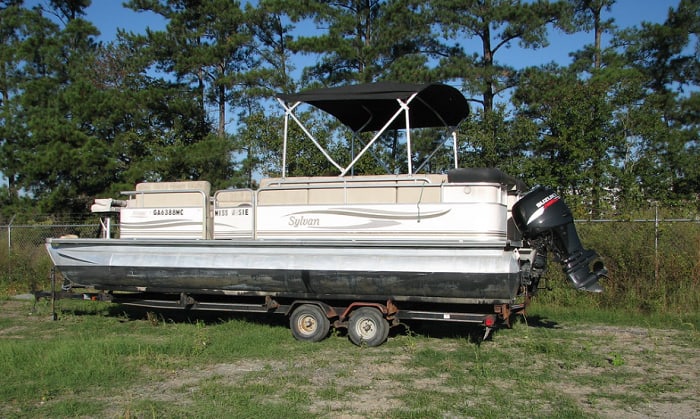Size is an important factor when buying boats, and the same applies to their trailers. While length is an obvious consideration, we should give some thought to how wide are pontoon trailers as well.
The width of a pontoon trailer should match the boat it’s used for with an average of 8ft or 8ft and 6in, depending on the model.
Keep reading to learn more.
Table of Contents
Pontoon Boat and Trailer Measurements
Having a properly sized trailer for the width of pontoon boat is important. Trailers need to match their dimensions to the watercraft they load to be able to properly support it.
The average width for pontoons is around 8 feet; however, widths will vary depending on each boat. The classification of a vessel is a good way to determine what width to expect for it. Below are standard dimensions for pontoon boats based on size.
- Small – below 20 ft long and 8 ft wide
- Medium – 20 to 24 ft long and 8 to 10 ft wide
- Large – over 24 ft long and up to 12 ft wide
Bear in mind, however, that many custom-made pontoons may not follow these standards. Some compact models fall below the standard 8 feet width, going as low as 6 feet.
Additionally, standard measurements for older and newer boats are different, with the older standard being 8 feet while the new standard is 8 feet and 6 inches.
Measurement That Matters
Length is one of two primary considerations, with the width usually matching up. There are also various trailers such as the Warlock pontoon trailer with adjustable dimensions.
When considering the right trailer size, it is recommended to have a few feet of extra length at around 3 to 4 feet. The length of a 20 foot pontoon boat trailer is enough for a 16-foot boat, and this will allow enough space in tight turns. Otherwise, the tube may hit your towing vehicle.
Weight is the other measurement that matters. There are many reasons why it is important to know the weight of your vessel and trailer, but one of them is to ensure stability while towing.
To have a better idea of trailer weight, let’s use standard figures as a sample. A 22-foot trailer will be a good fit for an 18-foot pontoon. Such a trailer will have a capacity of 4800lbs or 2177kg and a weight of around 900lbs or 408kg.
Other Pontoon Boat Dimensions on Trailer
When looking at the specs of a trailer, aside from length and width, we also have the height. Dimensions of pontoon boat on trailer matter when considering clearance for travel or storage. But how tall is a pontoon boat on a trailer?
Most boats will be 2 to 2.5 feet taller than their bridge clearance. This is important because if the vessel is not raised high enough, it may scrape the ground, especially on ramps and driveways, and this problem is more apparent in bigger models.
Center lift trailers may reach up to 3.5 feet or more, but these may be unstable, which can be a problem in a pontoon trailer kit.
Pontoon Trailer Considerations
Aside from having the proper dimensions to fit your pontoon, there are other important aspects to a good trailer as well. These include axle type, trailer style, and the necessary equipment.
1. Axle type
Choosing the right axle is one of the simpler things to do when looking for a trailer. The axle types are differentiated by how much weight they can support. The downside is that the more weight they can support, the more difficult it is to move them.
Single axle trailers are lightweight and easy to maintain but can only support up to 2250lbs or 1000kg, which is not enough for most medium-sized pontoons.
The tandem axle can support up to 4800lbs or 2177kg, while triple and multi-axle trailers are heavy duty types recommended for pontoons over 28 feet and can support over 6000lbs or 2721kg.
2. Trailer style
There are two styles of trailers available on the market today; they are the scissors style and the bunk. One very important consideration for many boaters is how easy it would be to unload their boat, and it is the scissors-style or center lift that is easier to manage.
However, this is the more dangerous type to use for a bunch of reasons, but we’ll stick to just two.
First is because of how the scissors-style works, it has trouble accommodating the tubes of big modern boats. The second is because of its lack of brakes.
The bunk style is the safer choice because of its well-balanced support. Aside from how the weight is supported, it helps where the support is placed, namely above the wheel and axles. This style is recommended especially for pontoons over 25 feet.
3. Necessary equipment
Many different items help make it easier to tow pontoons, but there are three that are essential for basic safety: brakes, blinkers, and extensions. Brakes are important because the additional load will make it more difficult for just the towing vehicle to halt movement.
Blinkers are usually required by local law enforcement, and also help keep you safe during travel. Extensions help keep the engine and fuel tanks in place even when exposed to vibration from road travel. Make sure to also have a winch for easier loading and unloading.
Conclusion
Now, you have a better understanding of proper pontoon trailer dimensions, including how wide are pontoon trailers and considerations for choosing the right one. Please leave us a message in the section below if you have anything to add to this discussion or any comments you’d like to share. We’ll be glad to hear from you.
Remember to boat safely.

“My intention from the first day establishing Boating Basics Online is to provide as much help as possible for boaters who want to experience a first safe and convenient trip. So feel free to join us and share your beautiful journeys to the sea!”



